Tosh Berman's Blog, page 191
November 11, 2015
'The "Scandal" of Marxism' by Roland Barthes (edited and translated by Chris Turner) Seagull Books
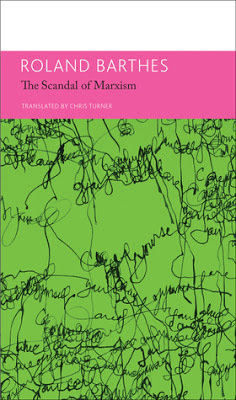 ISBN: 978-0857422392 Seagull Books'The "Scandal" of Marxism' by Roland Barthes (Translated by Chris Turner) Seagull Books
ISBN: 978-0857422392 Seagull Books'The "Scandal" of Marxism' by Roland Barthes (Translated by Chris Turner) Seagull BooksI look at the work of Roland Barthes as if he was a driver, and I'm sitting in the back seat. I tell him "take me somewhere interesting." That is what it is like reading Barthes essays. On one level I guess he's a philosopher, but I think he's more of a social critic commenting on History and the world around him. 'The "Scandal" of Marxism' is a collection of articles, interviews and essays regarding the role of politics in contemporary life, as it was written from the 1950s to the 1970s. Here you get his reflections on Marxism, The Algerian War, and the issues of the left and its role in literature as well as in politics. There is even a brief description of a trip to China he did with other intellectuals in 1975. China, a huge subject of course, but it seems he was a tad indifferent to it as a visitor or tourist.
The one thing that stands out for me as an American reader of this collection, is how the French divide and monopolize political movements and its publications. In America, we have liberal and conservative press, but it seems France has always had a right-wing press as well as a left-wing press, including publications from the Communists, the socialists, and so forth. So one can get a publication that for instance has a "Marxist" angle to the arts and culture. There is really no such publication produced for the masses here in the United States that conveys that aura of democracy and free thought. Barthes and others were public intellectuals (The U.S. don't even have intellectuals anymore) who express their experiences and well-thought out (not saying they were right or wrong) views on what is happening in their world.
Throughout this slim (and very beautiful) volume, Barthes attempts to define the role of Marxists as well as being part of the Left-wing. Not an easy thing to do, when the world was rapidly changing. Also there are so many issues that were taking place in the Left. Not all had the same opinion or thought! Nevertheless the translator and editor Chris Turner did a remarkable job in writing brief introductions to each essay/piece. He places the works in its timely culture, and what the issues were at the time.
Roland Barthes was one-of-a-kind thinker, who was more of a verb than a noun. Reading him is like watching a man or woman think. That I know sounds like watching wet paint drying on a wall, but in reality it's more interesting. The best thing in the world had to be in Barthes company, and just chatting with him - reading his works is that private conversation between reader and Roland Barthes.
- Tosh Berman
Published on November 11, 2015 10:46
November 9, 2015
"Stars Seen in Person: Selected Journals" by John Wieners (City Lights Books)
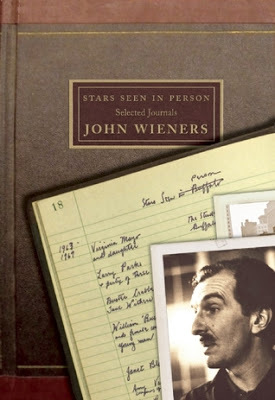 ISBN: 978-0-87286-668-3 City Lights Books
ISBN: 978-0-87286-668-3 City Lights Books"Stars Seen in Person: Selected Journals" by John Wieners (City Lights Books)
A poet's journal is always interesting, because it's looking into the mind of the poet, and one can trace the thinking pattern in what makes their work or writing happen. Or in some cases, not happen. It's very strange to come upon this book, because my dad, Wallace Berman, is mentioned in its pages - both in the introduction as well as in John Wieners' journal. At the time of writing "Blauuwildebeestefontein" journal, he was staying with us in Beverly Glen. So like a phantom, my dad does make an appearance, but alas, in the mind of Wieners it becomes a figure of importance, but alas, a faint mist.
The poetry / writing of John Wieners is very romantic. When he writes about his surroundings, or instance either Boston or Manhattan, it reads extremely glamourous. The city I often felt, were not made for citizens to live in, but for poets to comment on. The urban landscape becomes something else in the hands of a poet. John was (or is) a fantastic poet. He had an incredible eye for detail - in the sense that he was a great sketch artist capturing an image, but he would do it with words. The journals in this book (four of them) are sometimes a diary, in a very loose narrative, or straight ahead poetry. Sometimes a combination of the two - a narration as poetry. Nevertheless he captures angst in his words, and some of it is painful read, specifically about his one female lover (John was gay) and the child that didn't happen. Reading the unhappiness, I almost wanted to skip this part of the journal, but alas, it is either the pain or just his enormous presence on the page keeps the reader going.
In its simplicity, I love the last part of the journal where he just mentions a celebrity and where he saw that person. For instance:
"George Sanderspassing in Cadillac"
"Peter Lorre outside upperTimes Square Theatre"
The name that captured my attention is this section is Dean Stockwell and Bobby Driscoll, whom were not only actors, but very close friends to my dad and I have to imagine John knew them as well. It's interesting that he put them in the "Stars Seen in Person" category.
A beautiful book, with nice editing from Michael Seth Stewart, and a personal preface by Ammiel Allcalay, who met Wieners as a teenager. On a personal note, John Wieners was also my babysitter. A poet/babysitter is a very seductive quality for a future writer/publisher.
- Tosh Berman
Published on November 09, 2015 18:43
November 8, 2015
"Real Life Rock" by Greil Marcus (Yale University Press)
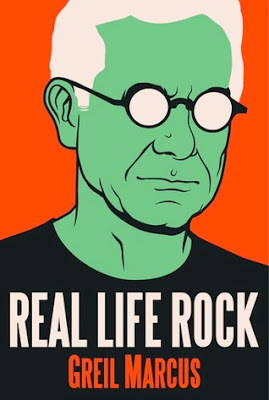 ISBN: 978-0-300-19664-1 Yale University Press"Real Life Rock" is Greil Marcus' long-term column of top-ten items per month. Written for various publications and websites. What is impressive is not his taste or opinion, but his ability to wander through pop culture and pick up the pieces that interest him the most. I don't always agree with his opinions, but I do admire the thought and writing skill that he uses to support his vision of culture on the run.
ISBN: 978-0-300-19664-1 Yale University Press"Real Life Rock" is Greil Marcus' long-term column of top-ten items per month. Written for various publications and websites. What is impressive is not his taste or opinion, but his ability to wander through pop culture and pick up the pieces that interest him the most. I don't always agree with his opinions, but I do admire the thought and writing skill that he uses to support his vision of culture on the run. For instance, he took the title "Real Life" from Magazine's first album. He loved the title of the album, but not the album itself. I, on the other hand feel that it is one of the great musical moments of the 1970s. And on top of that, he admires my father's (Wallace Berman) artwork, but thought the writing/essays were dull in the book "Support the Revolution" about my dad, which is silly, because I wrote an essay for that... Hey! Nevertheless, he is a superb writer, and I like how he thinks about music and how it relates to the bigger picture. The book is a collection of his columns from 1986 to 2014. "Real Life Rock" does not constitute a snapshot of the late 20th century, but more how Marcus sees the world around him, and his critical writing is very personal, as well as his taste, which is very consistent throughout the years. One sees Bob Dylan, The Doors, Joy Division, Gang of Four, The Mekons, Guy Debord, David Lynch, Robert Johnson, Yeah Yeah Yeahs, Eleanor Friedberger, Bryan Ferry, over and over again, but no David Bowie! No Sparks! In fact, there are a lot of music and musicians that he doesn't mention in any shape or form.
Which is OK, because this is Greil Marcus' world and we're allowed to go in, but we shouldn't bring in additional (critical or musical) guests. It's interesting to read his columns in one volume, instead of reading "Real Life" on a monthly basis. I would have often looked at Artforum Magazine on the newsstand, and the first thing I would look at is his column. I never get pissed off with his viewpoint, but I'm fascinated in how he uses music as a springboard into the other arts. The majority here is music, but there is theater, politics, film, and even TV commercials that he comments on. "Real Life Rock" is a good way to go into Marcus' brain to see how it works, and what comes up in his world. If you are a long-time reader of his column, there is usually nothing surprising, but on the other hand you do get his sense of aesthetic, and that is what I try to find in a critic. Not if he or she likes a work, but how they "see" that art. "Mystery Train" was my introduction, and "Lipstick Traces" made me a card-carrying fan, but I don't follow him blindly into the alley, but still, the adventure to go with him is quite good.
- Tosh Berman
Published on November 08, 2015 14:25
The Sunday Series: Sunday November 8, 2015
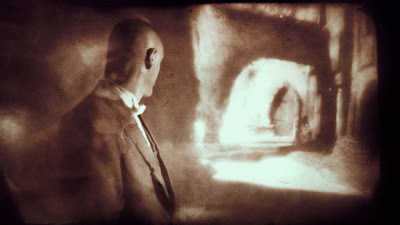
The Sunday Series:Sunday November 8, 2015
Today this Sunday, I went into a very dark room to see “The Forbidden Room.” The Egyptian Theater in downtown Hollywood is a structure that was built-in 1922. The first film projected on the screen at the theater was Douglas Fairbanks’s “Robin Hood.” It was also the first “Hollywood Premiere.” Today is another sort of premiere, where they will project “The Forbidden Room, ” which is on 35mm, and afterwards the filmmaker will burn the only existing print. The director, Guy Maddin” made this work as a tribute to the films that were made and are now lost. It has been noted that 90% of films made in the silent era are nowhere to be found. Mostly due to the chemical in these movies was nitrate film, and that type of the film is highly flammable. Also it was in practice to destroy film prints, when they were seen as not having any commercial value.
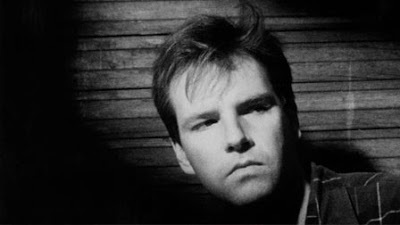
Guy Maddin in his introduction mentioned that “The Forbidden Room” is an homage to films that no longer exist, but at one time, did. He felt frustrated that not only were these works of cinema were lost to history, but also the fact that he wanted to see these films. In his mind, he needed to re-make these film-works so he can watch them. In a similar fashion of Mary Shelley making her Frankenstein monster out of used parts, Maddin and his assistants and co-director remade films out of memory or what one can presume is memory, but in reality it is a re-imagine of a work that once existed. Maddin realized that to make this work as not only something that exists, but he also would have to make it something that once existed. Therefore the one and only showing of “The Forbidden Room” took place this Sunday morning.
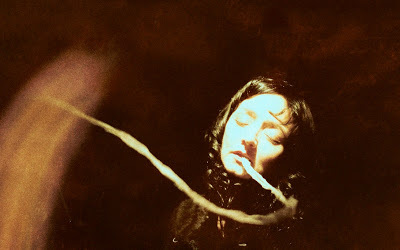
The soundtrack to “The Forbidden Room” is a compilation of memories as well. Snippets of movie soundtrack filtered through a ghost’s sense of importance. One can hear traces of familiar melodies, for instance Wagner, but it fades into the background as one watches the larger images on the movie screen. “The Final Derriere” by the band Sparks is a touching part of the scene where the main character has a desire to touch and obsess about a woman’s ass. He goes to a doctor to get a cure, and with his head split open and his brain being operated on, he now has great hopes to be free from his desire. Alas, there is no escape from desire. A woman’s ass is the entrance to heaven. Only a fool would attempt to fool his sense of direction. The same can be said for me, as I waited in line to see this film. There are no exits once you enter the theater of dreams, known as the Egyptian.
The smell of burning celluloid as Guy was in the projection room destroying the film within the film cans after showing the work. One could notice the smoke in the audience as it lingers towards the ceiling and every once in awhile, the projected light captures the texture of the smoke. Projected and real life became one in that instant.
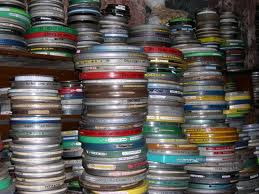
After the showing, one could really feel the smoke. Guy came out of the projection room holding a bucket of ashes, as he went through the audience going towards the front of the screen. He mentioned that what is in his hand is the latest work from him, and therefore it will be the last screening of “The Forbidden Room.” In true spirit of lost films, this film is now only exists in one’s memory. The experience of such a showing can last forever, and there will always be a Rashomon effect, where everyone’s memory will be different. Just trying to remember the images and the soundtrack to the film is already fading in my brain. Yet, the experience of living through such a screening, and its after-taste, surely will stay with me forever.
Published on November 08, 2015 11:52
November 2, 2015
"Allen Klein" by Fred Goodman (Houghton Mifflin Harcourt)
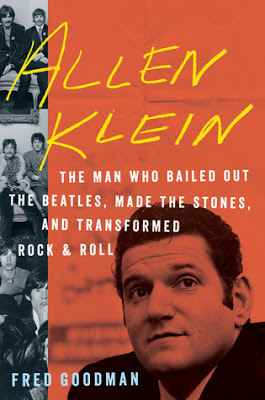 ISBN: 978-0-547-89686-1 Houghton Miffin Harcourt
ISBN: 978-0-547-89686-1 Houghton Miffin Harcourt"Allen Klein" by Fred Goodman (Houghton Mifflin Harcourt)
There are the artists, and there are the people behind the artists. I have always been fascinated with the figures behind the artists. Like the Wizard in the "Wizard of Oz," I suspected that if you pull the theatrical curtain open, not only would the artist be exposed, but also the mechanics or system that places the artist front and center. The beauty of such a system is that the consumer has a much-designed 'idea' what or who the artist is - but in fact, sometimes the wizard who is pulling the strings backstage is often the most fascinating figure in the narrative. They say the devil is in the details, and I'm not sure if Allen Klein is Satan or not, but surely he can find Satan in a business contract.
The subject matter of accounting practices is usually not that interesting to those who love the world of pop music, but in the hands and mind of writer Fred Goodman. He makes these individuals reach Shakespeare's height in drama and comedy. Allen Klein, a hardcore Jewish New Yorker, who had a Charles Dickens poverty typical childhood, had a deep understanding of numbers and what it can mean to a business or a relationship. For him, it is not the money that is important, but the game itself. Which is negotiating, arguing, and the results that can lead to power. Allen Klein had one major goal. To become the Beatles business manager. Goal number two: to become the Rolling Stones business manager. Which didn't make Mick Jagger happy to be in the number two bracket. Nevertheless, Klein became part of the music business as the world of the Brill Building was starting to take place. An early champion of Sam Cooke, and actually got his business together, he eventually attached himself to the 1960s British invasion by having the genius record producer Mickie Most as a client. That eventually led him to the world of The Rolling Stones and The Beatles via the route of Andrew Loog Oldham. The Stones co-manager and record producer, was the entrance way or door to the top of the British music world. What Klein did was make America part of the territory for the Stones upcoming invasion.
Books about businessmen are rarely interesting, but what we have here is a fascinating man who was quite creative in his business practices, and had an understanding of the role of the artist. He has always been pro-artist, in their fight against the corporation, in other words, the record label. Although Klein doesn't come off as a 100% hero, he is nevertheless a figure of great importance in the life of the Stones and The Beatles. The rise and mostly fall of Apple Records is told in great detail, and also the breakup of The Beatles. For anyone who is raised in Beatle-history, it's a very sad narrative. Klein would have preferred to manage The Beatles, but in the end, he had only 3 out of 4 members. Still, not a bad percentage in the field of accounting.
Fred Goodman is a very good journalist, and he can tell the story of numbers very well. Because in truth, this is not a story of accounting, but the characters surrounded in that world. And here we have Sam Cooke, Phil Spector, Oldham, Brian Epstein, as well as the Stones and the Fab Four. With characters like that, including the main subject matter of this biography, and being in good hands of Goodman, this book simply cannot fail.
- Tosh Berman
Published on November 02, 2015 09:06
November 1, 2015
The Sunday Series: Sunday November 1, 2015
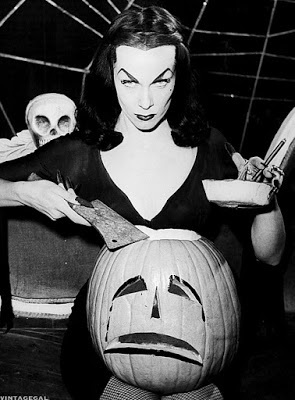
The Sunday SeriesSunday November 1, 2015
Sunday. Dumb-day. No-day. All-day just thinking how boring Sunday is. The relaxation of a whole population is perhaps the most negative aspect on what many consider to be the first day of the week. To greet the new week in such a fashion, is like running full-force against a brick wall. The only saving grace for me, is that the Downtown Library is open from 1 PM to 5 PM. At least in those four hours, there is a sense of bliss compared to the agony of the other 20 hours that exist on a Sunday. I’m always shocked when I see the importance of “nothing” on our culture. The blankness of the day, and I guess the fact that we don’t even get mail delivered on Sunday is a blessing to some. A day without getting a bill. Then again, I do see postal trucks around town delivering more likely Amazon “Advantage” purchases. To be a consumer on a day off is like the work itself.
So boring, even dogs take a day off, and force their owners to walk them around the house. I wonder if it’s the dog or the owner that makes the decisions in the household. I suspect that a dog has a seductive power over the human, and therefore a master/slave relationship is at work. From my window I see a pretty girl walking by with her dog, and I think “lucky pup.” As for me, I’m drinking the last bottle of Trader Joe’s “Charles Shaw” in the house, and wondering what happened to my finances. Where did my world go. “Do you remember Walter?” I don’t think he does, or his senile brain is thinking of memories that are made-up, and sadly, I’m not part of the big picture in his life.
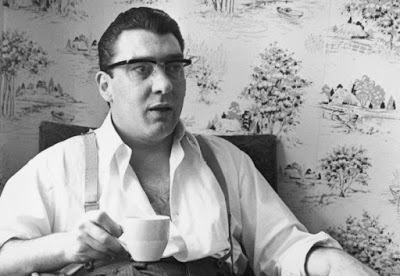
It is a day after Halloween. I dressed up in a costume on one will ever figure out who it is. Me. The truth is, I have always worn a halloween costume, but no one has paid that much attention to it. When I close my eyes, I have always taken on the role as the murderer. It is the only profession where I felt suitable to be in. In my private notebook, I have kept a list of people who I wanted to do away with. In alphabetical order by last name. Men and women, but oddly enough, more men are listed in my list of people of the soon-to-be-past. I don’t know why I’m so gender-orientated. I have heard from others, that they think of me as a homosexual. I do admire Ronnie Kray, but who wouldn’t, with his good taste in glass eye-wear.

As I sit here, getting slowly more drunk, I think of the opportunities I turned down, either due to fear of change, or the fear of not getting back from where I came from. My whole world is really here, sitting by the round dining table, marking time, by doing nothing except drinking, if the worst, at the very least, the cheapest wine on the market. One man’s high is another man’s hell. I want to wish you a very happy Sunday, for those who take the day as a reflection or mediation. As for me, I like to be medicated before I even put my foot down on the cold bedroom floor before leaving the bed.
- Tosh Berman
Published on November 01, 2015 08:19
October 31, 2015
"Francis Bacon In Your Blood" by Michael Peppiatt
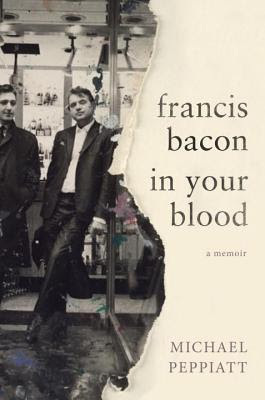 978-1-63286-344-7 Bloomsbury Publishing
978-1-63286-344-7 Bloomsbury PublishingMichael Peppiatt's memoir of life with the great painter Francis Bacon is rich in alcohol and every expensive meal they ate. If Peppiatt added recipes to this book, it would have been one of the great cookbooks of all time. On the other hand, we have lives here that spent the greatest of all possible times. Depression is around the corner, but when you're drinking the finest alcoholic drinks and eating food like today will be your last, it is hard to feel sorry for the participants in Bacon's life. The one thing I love about Francis Bacon is his mystique. On one level, he's very obvious and seems to be easy to read, but the truth is that he's' quite a complex character.
Peppiatt's memoir or narrative mainly takes place in Soho London and Paris. One can't imagine Bacon existing in another city than those two. Bacon, is without a doubt, one of the great citizens of London. Who wouldn't want to spend time under his expertise as a guide to the underworld of various expensive restaurants, nightclubs and numerous (often seedy) bars. In his world, painters as well as East-End gangsters show up, and is a heady mix of a sense of danger and having a great meal at the same time.
"Francis Bacon In Your Blood" is just as complex as its subject matter. Peppiatt is known for his excellent Bacon biography "Anatomy Of An Enigma." Of the two, the biography is the better book. The memoir here is almost like a sketch book of notes regarding the author's time with Bacon, which overall, was pretty intense. Bacon, I suspected, that once he liked you, one is forever in his circle till he either destroys you or fatten you up - and in no way or fashion could I have existed in his world - just on the drinking and eating of extremely rich foods. The fact that he lived to the of 80-something is remarkable, considering his drinking and eating habits. The excess of his life is fully exposed in Peppiatt's memoir, and what is interesting is how one can survive such a pleasurable nightmare.
Peppiatt does all the right things in his book, but I feel it needs a stronger editorial help. A lot of the stories are repeated by Bacon (as they were in real life), but not necessary in a book form. This is a huge book, and I think it would have been a better read if it was half its size. The only thing that I found interesting in Peppiatt, besides his closeness to his subject matter, is when he became an editor of "Art International." Mostly due to my interest in publishing. If he was going to write on anything else besides Bacon, I would have liked to read actually more about his publishing a magazine. The fact that Peppiatt is straight and compared to Bacon's other colorful friends, he doesn't come off that interesting. I'm not clear why Bacon found him so interesting enough to put him squarely in his world. Perhaps he needed someone that was sort of neutral in his life, so he can talk. Perhaps like one who confesses to a priest, he needed a listener who wouldn't have an attitude towards him. And in most cases, Peppiatt was a very good friend and listener to Bacon's rants, complaints, and his love for the 'dirty' life of Soho London and elsewhere.
Book is released in December, 2015.
- Tosh Berman
Published on October 31, 2015 18:56
October 28, 2015
"Mallarmé on Fashion" by Stéphane Mallarmé (Edited and translated by P.N. Burbank & A.M. Cain)
 ISBN: 9781859737231 Berg
ISBN: 9781859737231 BergThe only reason I would be reading a book about a French fashion magazine that existed in 1874, is if there is something odd about the magazine and its editor. In two words: Stéphane Mallarmé. Whatever mysterious reason, Mallarmé, who is without a doubt one of the great poets that came from France, had a job where he not only edited, but also wrote the entire magazine, using various alias. He managed to produce eight copies of "La Dernière Mode." "Mallarmé on Fashion" is a pretty interesting book on multi-levels. One, is the thought of such an avant-garde poet of his time and place, working on a fashion magazine in such complete control, as well as a bit of fashion history, but also the importance of fashion in French culture. Especially in the 19th century.
Mallarmé writes as a woman as well as a man in this magazine. The magazine is very formalized in its format. As "Madame de Ponty" she writes about contemporary fashion trends in Paris, and elsewhere. As "Ix" (now that is a mysterious name) he's a stuffy theater and book critic, and mostly has a certain amount of anger about music taking over text on the Parisian stage, and then there a food section, where they have elaborated menus and recipes. There is also a correspondence section, whereas the editor, he gives fashion advice, and also a travel section as well, recommending travel points and where to stay on vacation. At the end of the issue, Mallarmé offerer what is best in Parisian entertainment for that month or season. He covers everything from music hall entertainment, opera to city parks. It is very much like Time Out or Los Angeles Weekly directory.
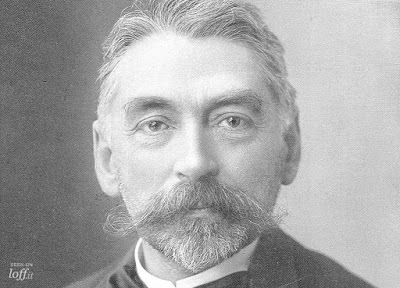 Stéphane Mallarmé
Stéphane MallarméMallarmé was known to be interested in the decorative arts, so it's not a huge surprise that he would write about interior design of rooms, but his intense knowledge of fashion is totally new to me. In an odd way, Mallarmé is actually critiquing the fashion world, but even more so, the fashion magazine. I think he sees it as a window to what is happening culture wise - so readers now, get a unique portrait of Paris 1874, through the eyes of Mallarmé, but him using various identities to convey that world. Again, it is clearly not known why he did this. It could have been for a paycheck, but it is interesting that he did so, by not just writing one column, or as editor - but doing it all! In many ways, it was an upscale zine of its time. He wanted to do more than eight issues, but the publisher (not him) pulled the plug on the project.
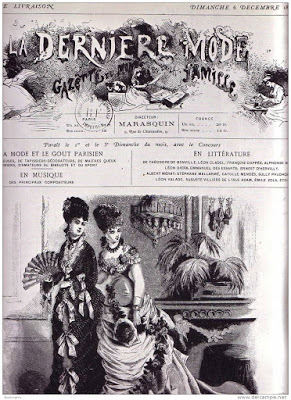 La Dernière Mode, 1874 (Edited and written by Mallarmé
La Dernière Mode, 1874 (Edited and written by Mallarmé"Mallarmé on Fashion" is very much a scholarly text book, and is geared for the lit-crit lunatic, but it is also an essential book on anyone studying Parisian culture of the 19th century as well as what 'pop culture' was like in those days. Editors and translators P.N. Burbank and A.M. Cain do a great job in presenting Mallarmé in the hard (not delicate) world of high and low fashion. Fascinating book.
Published on October 28, 2015 15:35
October 27, 2015
"Autoportrait" by Edouard Levé (Translated from the French to English by Lorin Stein)
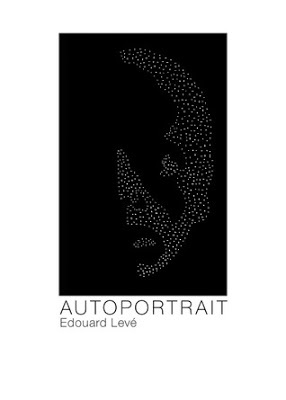 ISBN 9781564787071 Dalkey Archive
ISBN 9781564787071 Dalkey Archive Without a thought in my head, I went to Stories Bookstore and Cafe in Echo Park, and decided to purchase a copy of Edouard Levé's "Autoportrait." I have heard of this book through Dennis Cooper's blog, and reading about "Autoportrait" made me curious to go get the book itself. After purchasing it, I went directly to the Echo Park Library, or Edendale Libray as it is officially known, to start reading the book. I didn't leave the library till I finished the entire book.
Once you start it, the writing of this short work of literature (not sure if it's officially fiction or memoir) is hard to stop reading. Rarely have I ever read a book where I was compelled to read the whole thing in one sitting. I'm glad that I did, because I think if one stops reading "Autoportrait," you would lose the rhythm of the language and sentences. Basically "Autoportrait" is a collection of facts regarding the writer's life and thoughts. There are sentences like "I get excited by the idea of reading the biography of an author I love, then when I actually do it I lose steam." Which is perfectly factual in a sense, but I'm not sure if he really means all biographies he feels that way, or just some. Perhaps the one's that are 'only' about his favorite writers. The book is actually full of sentences that can be either meaningful and quite textural, or just the facts sir, in the style of Jack Webb's narration in the TV show "Dragnet."
For me as a reader, the textures and pacing of the language he uses is quite hypnotic. As I mentioned it was hard for me to put down this book, not because I wanted to know what will happen in the end, but just where he is going with this style of writing and format. The book is very similar to the writings of George Perec and Joe Brainard - two writers he mentions in passing in "Autoportrait." Joe Brainard's "I Remember" is very subjective, because it is how he remembers a certain time in his life, yet Levé is working in the same format, but the results are different. Perec likes to play literary games, and I think Levé was a fan of both writers (just what I read out of this book - by his style alone) that in many ways, reads like a tribute to Brainard and Perec. "Autoportrait" doesn't have a lot of psychology, in fact, it is almost reading the surface of someone. Yet, one picks up little clues here and there. Towards the end of the book, he mentions a friend who before going out to play tennis he went back to the house to shoot himself. Which describes a person who thought out his suicide, but then I started to think why did he make arrangements to play tennis with his wife. There is a coldness in the text that is disconcerting. I did know that Levé committed suicide, so perhaps he was thinking about the nature of taking one's life. On the other hand, Levé seems to have a full-life before his end. He traveled well, and it seems he loved and had relationships, so the mystery of why one would do something like that, is still a mystery in this book as well.
When I read "I Remember" I get a full portrait of its author Joe Brainard. I don't feel that way after reading "Autoportrait." It is not a work of full exposure of a human being, but maybe just the facts of how one lives in their lives. Brainard is like Proust, and Levé is a minimalist by design. It is obvious he's a man who likes structures, or has a belief in the world of the system. Yet, that specific structure doesn't tell much. But then again, what is there to tell? "Autoportrait" is a remarkable piece of literature, but it is also I think a good book about the art or the artlessness of 'good writing. Those who write, should be for sure, read this book.
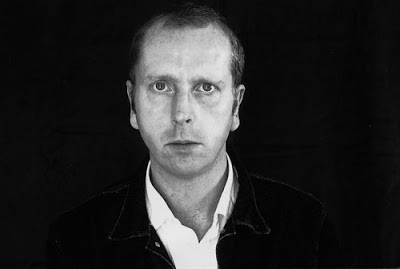 Edouard Levé
Edouard Levé
Published on October 27, 2015 17:24
October 25, 2015
The Sunday Series: Sunday October 25, 2015

The Sunday Series:
Sunday October 25, 2015
The eyes show your soul and the mouth shows what you’re really are. I have a mouth of broken teeth. Some are from decay, mostly due to fighting. I have a face that people want to punch. It’s odd, because I’m by my nature a very quiet man. I never want to cause trouble onto anyone, yet, people seem to have great pleasure in hitting me in the mouth. After getting hit, I never feel the pain, just a numb sensation that something has changed within me. The first awareness is having your tongue go over the wound and the jagged surface of once where a tooth was in place.
Losing a fight is not a problem with me, but the vanity aspect of having my appearance changed, and therefore exposing a side of me that I wish was hidden from the public - especially from the females. The first thing one looks at is the mouth, and you can see people judge one by how that area of the face looks. I do it all the time, especially with strangers. If they have a strange set of teeth, I wonder why. I then imagine them if they had proper choppers, instead of the mess that’s in their mouth. So why would anyone think of me differently. A scar sometimes shows character, but a broken tooth is just what it is - a sign of failure of some sort.

I have to imagine what it must be like for a woman to kiss me with her tongue. I have a chipped tooth that is sharp as a blade. I often cause my lip to bleed when I’m deep in thought while reading a book, and all of sudden a sharp pain comes up, and I can taste the blood from my lip. I have a fear of causing a puncture of a woman’s lips because of the teeth. In fact, there is usually not a moment when I’m not thinking of my teeth.
I have often had dreams of losing a tooth, and it’s odd to lose that specific tooth in real life. Due to the nature of my mouth, if one tooth is gone, it changes the entire landscape that is in my mouth. In my dreams, I have noticed that there is a tooth missing, but I’m with a beautiful woman, and I’m hoping that she won’t notice the missing tooth in my mouth. Then there is a feeling that she is aware, but not saying anything. In fact, she is making some sort of judgement against you, or wondering why you don’t get your teeth fixed. I feel the anxiety of poor dental care, not due to pain, but what others think of me.
Since I can’t afford a dentist, and on top of that, all of them are suspicious to me. They all resemble that doctor I have seen in countless noir films, where the criminal is on the run, and he gets wounded - and someone calls a doctor at 3 AM in the morning, and they show up in some abandoned warehouse. Well, that is what a dentist looks like to me. For some reason or another, they don’t seem to be the same as an official or licenced medical doctor. I don’t fully understand why they are different, or one needs a separate insurance policy for dental services.
Nevertheless, I neither have dental insurance or the money to pay for such service. Therefore I decided the best thing to do is actually painted my teeth black. I’m fascinated with Japanese women who blacked out their teeth. They call it “ohaguro.” In the Meji period, aristocrats would have blackened teeth. It seems my major problem is not the teeth, but I was born in the wrong culture, class structure, and of course, time. But here, in Los Angeles, and on a Sunday, it is a dental problem.

I have read that Japanese military commanders who were hit in the face or head, would wear women’s make-up to disguise the scarring of the face. On top of that, they would dye their teeth black. Since I now feel disfigured by the gap in my mouth, I decided to dye my teeth as well. My visual representation was a picture of a Noh mask. On top of that, I also shaved my eyebrows, due to the fact that they are bushy and grew like a wild weed above my eyes. If I can’t get rid of the ugliness of my face, at least I can have some power over the results of the violence, I have encountered. If choice of being disfigured by nature or human violence, I rather do the scarring by my own hand.
There is the feeling that one would want to do a little bit at a time, but the anxiety that is within me will always make it feel like that it’s the main entry-way to my personality and very being. To do things extreme, will show a sense of character on my part. To destroy such a beautiful face, will free me in the long time.
Published on October 25, 2015 14:02



